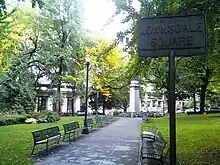Plaza Blocks
The Plaza Blocks, two courthouse squares known as Chapman Square and Lownsdale Square, are located in downtown Portland, Oregon, United States.[1] The blocks are north of Terry Schrunk Plaza and east of City Hall. The northmost square is named after Daniel H. Lownsdale (1803—1862), a native Kentuckian who settled in Portland in 1845.[2] The south square is named after legislator William W. Chapman (1808–1892), a Virginian settled in Portland in 1850.[3]


By 1900 Lownsdale Square, traditionally a male-only space, was a gay cruising destination, allowing a degree of deniability. It was simply called "the park". The activity also took place in Chapman Square by the 1950s.[4]
Southwest Main Street separates the two blocks; Thompson Elk Fountain, which was donated to the city by former Portland mayor David P. Thompson, has stood in the middle of the street.[5] The sculptor was Roland Hinton Perry.
The first electric power transmission line in North America terminated at Chapman Square. It went online at 10:00 pm on June 3, 1889, operating at 4,000 volts of direct current, with the lines between the electric generating station at Willamette Falls in Oregon City, Oregon, and downtown Portland stretching about 13 miles. A bronze tablet in the park commemorates this achievement.
See also
References
- Insiders' Guide® to Portland, Oregon, 7th Rachel Dresbeck - 0762774770 2011 - Page 227 "Chapman Square, the southern square, was donated to the city by early Portland attorney William Chapman, while Lownsdale Square was contributed by Daniel Lownsdale, who arrived in Portland in 1845.The squares were originally popular sites for public oratory and other gatherings. And they have a quaint history-at one time, the idea was that women would gather at Chapman Square, while the men would have Lownsdale to themselves. Lownsdale Square is the home of the Soldiers' Monument from 1906, a granite pillar supporting the likeness of an infantryman. This soldier represents Oregon's contribution to the first major force of American troops dispatched overseas, the Second Oregon United States Volunteer Infantry. "
- "Lownsdale Square". Portland Parks & Recreation. Retrieved November 16, 2011.
- "Chapman Square". Portland Parks & Recreation. Retrieved November 16, 2011.
- Boag, Peter (2003). Same-Sex Affairs: Constructing and Controlling Homosexuality in the Pacific Northwest. Berkeley: University of California Press. p. 115. ISBN 0-520-24048-0.
- Terry, John (November 20, 2011). "Thompson Elk has seen a lot of city history [print edition title]". The Sunday Oregonian. p. B2. Retrieved June 29, 2014.